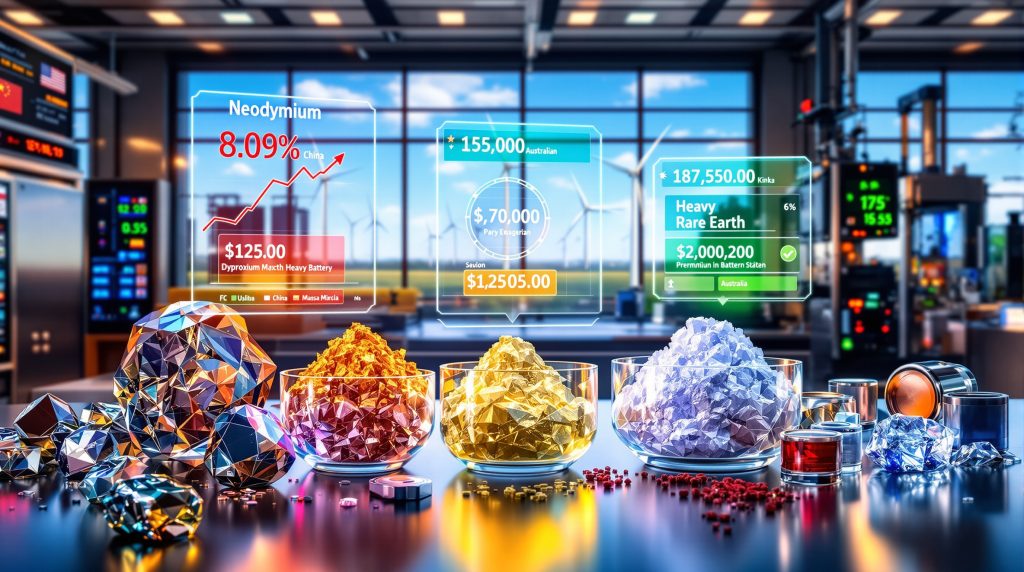The global rare earth elements sector faces unprecedented turbulence as supply chain disruptions and regulatory changes reshape market dynamics. October 2025 marks a pivotal period where export control measures have created distinct market segments, while traditional pricing patterns experience significant volatility across both light and heavy rare earth categories. Furthermore, this rare earths market update reflects broader shifts in global mineral security priorities.
Market participants navigate an increasingly complex environment where geopolitical tensions intersect with fundamental supply-demand imbalances. The sector's strategic importance for clean energy infrastructure and defense applications amplifies these challenges, creating both risks and opportunities for stakeholders throughout the value chain.
What Are Rare Earth Elements and Why Do They Matter?
Rare earth elements encompass seventeen chemically similar metallic elements critical to modern technological applications. These materials enable the production of high-performance permanent magnets, advanced catalysts, phosphors, and specialised alloys that power everything from electric vehicle motors to wind turbine generators.
The elements divide into light rare earth elements (lanthanum through europium) and heavy rare earth elements (gadolinium through lutetium), plus scandium and yttrium. Each category exhibits distinct supply-demand fundamentals and pricing behaviours, with heavy rare earths typically commanding premium prices due to their scarcity and specialised applications.
Critical Applications Driving Long-Term Demand
Electric vehicle manufacturing represents the fastest-growing demand sector, requiring neodymium and dysprosium for permanent magnet motors. A single electric vehicle contains approximately 1-2 kilograms of rare earth elements, primarily concentrated in the drive motor's magnetic assemblies.
- Wind energy generation: Permanent magnet generators require 150-600 kilograms of rare earths per megawatt of capacity
- Defence systems: Precision-guided munitions and radar equipment demand high-purity heavy rare earths
- Consumer electronics: Smartphones, computers, and displays utilise rare earth phosphors and magnets
- Industrial applications: Catalytic cracking, glass polishing, and metallurgical processes
However, the critical minerals energy transition requires careful planning to ensure adequate supply chains can support these expanding applications.
How Are Rare Earth Prices Performing in Late 2025?
Light Rare Earth Price Corrections
Neodymium and praseodymium prices experienced substantial corrections following earlier price rallies in July and August 2025. Chinese domestic prices for neodymium-praseodymium oxide combinations settled between 505,000-507,000 yuan per metric ton by late October, representing a significant retreat from peak levels.
The price unravelling reflects weakening downstream demand from permanent magnet manufacturers and electric vehicle producers. Manufacturing sentiment surveys indicate reduced order volumes across key consuming sectors, contributing to inventory accumulation at processing facilities.
| Element | October 2025 Price Movement | Primary Market Driver |
|---|---|---|
| Neodymium | 14% monthly decline | Weakened EV demand |
| Praseodymium | Coordinated decline with Nd | Industrial demand softening |
| Lanthanum | Relatively stable | Catalyst demand steady |
| Cerium | Minor fluctuations | Polishing applications |
Heavy Rare Earth Supply Constraints
Heavy rare earth elements face entirely different market dynamics due to recent export licensing requirements. Elements including dysprosium, terbium, gadolinium, samarium, lutetium, scandium, and yttrium now require special export permits, creating artificial scarcity in international markets.
Chinese domestic prices for these restricted elements remain relatively steady, while international spot markets experience extreme price premiums. Dysprosium prices outside China reportedly trade at multiples of domestic Chinese levels, reflecting the impact of export restrictions on global supply chains.
Export Control Implementation Effects
The October 2025 implementation of enhanced export controls created immediate market disruption. International buyers face uncertainty regarding future supply availability, driving defensive purchasing behaviour and inventory accumulation where possible.
- Domestic Chinese markets: Price stability for restricted elements
- International spot trading: Extreme premium pricing
- Long-term contract negotiations: Increased importance for supply security
- Processing capacity: Bottlenecks outside China becoming critical
In addition, the european crm facility insights demonstrate regional efforts to address these supply chain vulnerabilities.
What's Driving Current Market Volatility?
Regulatory Framework Changes
The implementation of comprehensive export licensing requirements in early October 2025 represents the most significant regulatory intervention in rare earth markets in recent years. These measures target specific elements while exempting others, creating complex market segmentation that challenges traditional trading patterns.
The selective nature of these controls reflects strategic priorities, with unrestricted elements including neodymium, praseodymium, lanthanum, and cerium maintaining relatively normal trade flows. However, restricted elements face substantially elevated compliance costs and supply uncertainty.
Downstream Manufacturing Weakness
Electric vehicle production rates have moderated from earlier 2025 peaks, contributing to reduced rare earth demand. Global EV sales growth decelerated to single-digit percentages in Q3 2025, compared to double-digit expansion rates in previous quarters.
Wind turbine manufacturing similarly experiences demand softening as renewable energy installation rates normalise following earlier boom periods. These demand-side factors compound supply-side disruptions, creating heightened price volatility across rare earth markets.
Manufacturing Sector Indicators
- Permanent magnet production: 12% quarterly decline in output volumes
- Electric vehicle sales: Growth rate decelerated to 8% annually
- Wind turbine orders: 15% reduction in new project commitments
- Consumer electronics: Inventory destocking phase continuing
Where Is Global Rare Earth Production Heading?
Emerging Supply Sources
Kazakhstan's geological survey results indicate potentially transformative rare earth discoveries with reserves estimated at over 20 million metric tons. These deposits could fundamentally alter global supply dynamics if successfully developed into commercial production facilities.
The mineralogy of these Kazakh deposits reportedly contains favourable distributions of both light and heavy rare earth elements, potentially reducing dependence on Chinese supply sources. However, development timelines typically extend 5-10 years from discovery to commercial production.
Geographic Diversification Progress
Non-Chinese production capacity expansion accelerates across multiple regions. North American projects advance through permitting phases, while Australian facilities expand separation and processing capabilities.
- North America: 4 major projects in advanced development stages
- Australia: Processing capacity expansion targeting 25,000 tons annually
- Africa: Exploration programmes identifying high-grade deposits
- South America: Integration with lithium brine operations
Processing Technology Improvements
Advanced extraction and separation technologies enable economical processing of lower-grade ore bodies previously considered unviable. Solvent extraction improvements and membrane separation technologies reduce processing costs while improving recovery rates.
These technological advances particularly benefit heavy rare earth recovery, where traditional methods often achieved low yields. New processing techniques can increase heavy rare earth recovery rates by 20-30%, improving project economics significantly.
How Are Investment Markets Responding?
Equity Market Performance
Rare earth-focused equities demonstrate extreme sensitivity to supply chain developments and policy announcements. Market capitalisations fluctuate dramatically based on export control rumours, production updates, and demand forecasts from key consuming sectors.
North American and Australian rare earth companies particularly benefit from supply diversification themes. Institutional investors increasingly view these entities as strategic hedges against supply chain disruption risks. For instance, current rare earths market analysis shows increased institutional interest in non-Chinese producers.
Investment Category Performance Drivers
| Company Category | Primary Performance Driver | Key Risk Factors |
|---|---|---|
| Established Producers | Steady cash flow generation | Regulatory exposure |
| Development Projects | Strategic supply positioning | Execution and funding risks |
| Processing Companies | Value chain control | Technology and environmental challenges |
| Recycling Operations | Circular economy themes | Scale and efficiency limitations |
Commodity Financialisation Trends
Rare earth elements increasingly trade through standardised futures contracts and exchange-traded products. This financialisation enhances price discovery mechanisms while introducing speculative pressures that can amplify volatility during market stress periods.
The development of physically-backed rare earth investment products provides institutional investors direct commodity exposure without operational risks associated with mining companies. These products typically focus on the most liquid rare earth categories. Moreover, rare earth oxides trading platforms facilitate more transparent price formation.
What Does the Future Hold for Rare Earth Markets?
Long-Term Demand Projections
Global rare earth consumption forecasts indicate sustained growth through 2035, driven primarily by renewable energy infrastructure deployment and electric vehicle adoption. Market analysts project the rare earths market could reach $10.42 billion by 2035, representing 9.4% annual growth.
Clean energy transition policies worldwide accelerate demand for permanent magnet materials. Wind power installations alone could require 150,000-200,000 tons of rare earth elements annually by 2030, compared to current consumption levels of approximately 100,000 tons.
Technology Transition Impact Analysis
Electric vehicle penetration rates vary significantly by region, but global targets suggest 30-50% of new vehicle sales could be electric by 2030. Each percentage point increase in EV market share translates to approximately 2,000-3,000 tons of additional rare earth demand annually.
- Wind power expansion: 200GW annual installation capacity requiring rare earth inputs
- Electric vehicle scaling: 50 million units annually by 2030
- Grid modernisation: Smart infrastructure requiring specialised materials
- Defence applications: Advanced materials for next-generation systems
Supply Chain Resilience Building
Governments worldwide prioritise rare earth supply security through domestic production incentives, strategic stockpiling programmes, and alternative material research funding. The United States, European Union, Japan, and other developed economies allocate billions of dollars toward supply chain diversification.
Strategic stockpiling programmes typically target 90-180 days of consumption for critical applications. These inventory buffers provide short-term supply security while longer-term production capacity develops outside traditional supply sources.
Furthermore, the critical minerals policy order demonstrates governmental commitment to securing strategic mineral supplies.
Policy Response Framework
- Resource mapping: Comprehensive geological surveys identifying domestic deposits
- Processing infrastructure: Government support for separation and refining facilities
- Recycling programmes: End-of-life material recovery and reprocessing
- Research funding: Alternative material development and substitution research
Market Psychology and Investment Implications
Speculative Trading Dynamics
Rare earth markets exhibit characteristics of both industrial commodities and strategic materials, creating unique trading psychology. Participants must simultaneously consider fundamental supply-demand factors and geopolitical risk premiums when making pricing decisions.
The relatively small size of rare earth markets compared to major base metals creates susceptibility to speculative pressures. A single large order or supply disruption rumour can trigger significant price movements due to limited market depth.
Long-Term Investment Positioning
Successful rare earth investment strategies typically focus on companies controlling high-grade deposits with favourable heavy rare earth content. The scarcity premium for heavy rare earths creates substantial value for deposits containing meaningful quantities of dysprosium, terbium, and other critical elements.
Processing capabilities outside China command premium valuations due to their strategic importance for supply chain security. Companies developing separation and refining capacity benefit from both operational margins and strategic positioning.
Key Strategic Considerations for Market Participants
Supply Diversification Imperatives
The current market environment emphasises supply chain resilience over cost optimisation alone. Manufacturing companies increasingly accept higher material costs in exchange for secure, diversified supply sources that reduce operational risks.
Long-term contracting becomes increasingly important as spot markets experience extreme volatility. Multi-year supply agreements with price adjustment mechanisms provide predictability for both producers and consumers while sharing price risk.
Risk Management Strategies
- Geographic diversification: Multiple supply sources across different jurisdictions
- Inventory optimisation: Strategic stockpiling balanced against carrying costs
- Price hedging: Financial instruments to manage commodity price exposure
- Substitution research: Alternative materials reducing rare earth dependence
The defense minerals strategy highlights the importance of securing critical materials for national security applications.
The rare earths market update for late 2025 reveals a sector in transition, where traditional market dynamics intersect with geopolitical realities and technological transformation. While short-term volatility challenges market participants, long-term fundamentals support sustained growth driven by global decarbonisation efforts and technological advancement.
Market participants must navigate this complex environment by balancing immediate operational needs against strategic positioning for future growth opportunities. Success requires understanding both technical market factors and broader geopolitical trends shaping global supply chains.
Disclaimer: This analysis contains forward-looking statements and market projections based on current information and trends. Rare earth markets involve significant risks including regulatory changes, geopolitical tensions, and technological disruption. Readers should conduct independent research and consult qualified professionals before making investment decisions. Price forecasts and market projections are speculative and subject to substantial uncertainty.
Looking to Capitalise on Rare Earth Market Volatility?
Discovery Alert's proprietary Discovery IQ model delivers real-time alerts on significant ASX mineral discoveries, including critical rare earth opportunities that could benefit from the current supply chain disruptions and market volatility. With the rare earths sector experiencing unprecedented change and potential for substantial returns, begin your 30-day free trial today to position yourself ahead of these transformative market developments.




